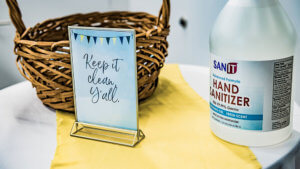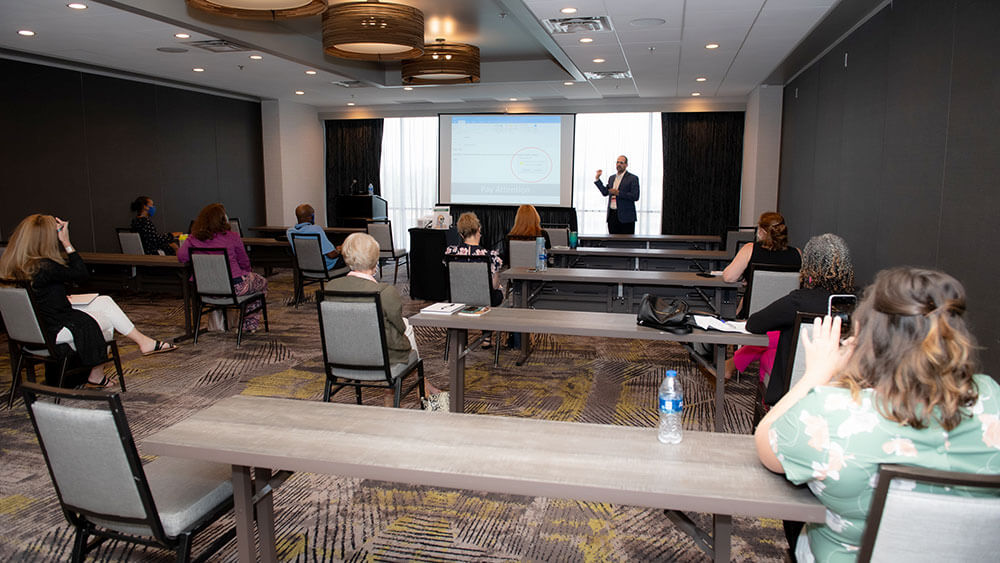
In August, the Georgia Society of Association Executives (GSAE) successfully held its annual meeting at the Hyatt Regency Savannah. “I was very proud of the way everyone embraced and followed the rules,” said Wendy W. Kavanagh, CAE, president of GSAE.
When Wendy W. Kavanagh, CAE, president of the Georgia Society of Association Executives (GSAE), held the association’s annual meeting last month at the Hyatt Regency Savannah, attendance totaled just 113 people. That’s just less than half GSAE’s typical size for the event, but Kavanagh said that that was by design.
“We certainly had members who said, ‘I’d love to, but I can’t. I’m uncomfortable with it, even with these safety guidelines, I’m just not ready,’” Kavanagh said. However, “we weren’t trying to change people’s minds — we were providing an option for the people who wanted to meet in person.” For members who couldn’t attend in person, GSAE partnered with both the Ohio Society of Association Executives and the Florida Society of Association Executives to offer member-pricing to their respective virtual-only conferences.

GSAE provided additional hand-sanitizing stations at registration. “The conversation we had at [GSAE] was, ‘We will exceed safety procedures — we will do more than,’” Kavanagh said.
“We made a covenant with our attendees, that we will do everything in our power to help you model the good behavior that we’re being told will keep you safe, or keep you from getting sick or feeling uncomfortable,” Kavanagh said. It was key, she said, to give attendees an idea of what to expect, so GSAE communicated their health and safety procedures ahead of time via e-mail and GSAE’s website. Attendees could also review them via GSAE’s event app, which they also used to complete health assessments every morning during the meeting in addition to daily temperature checks.

The GSAE team made an effort to educate attendees on what provisions would be in place ahead of the event, “so nobody was surprised to see a six-foot table with chairs on either end,” Kavanagh said.
‘You can’t learn if you’re uncomfortable’
Much of GSAE’s schedule was dedicated to professional development, so well-distanced meeting spaces were a must. Rooms were set to less than 25-percent capacity with eight feet of space between attendees and speakers. Setups included crescents with 72-inch rounds with four forward-facing chairs or six-foot tables with a chair on either end. The goal, Kavanagh said, was help attendees pay attention. “You can’t learn if you’re uncomfortable,” she said, “if you’re sitting there worried about how close the next person is.”
Most social activities were held outdoors, like bike tours and dine-around dinners. The group also opted for open-air group transportation, including streetcars operating under capacity. Masks were required at all times except while eating and drinking.
For meals and receptions, Kavanagh utilized extra-large indoor or outdoor spaces for easier physical distancing. Breakfast was served grab-and-go style, and lunch cafeteria style — setups that required extra labor as well as some logistics tweaking. “It was much more labor intensive for the hotel staff,” she said. For their “Taco Tuesday” lunch, the hotel set up numerous stations spaced far apart, all with the same menu items. This helped to cut down on crowding and movement, as well as to make the process go faster.
To do this, the hotel’s team came up with a color-coded system. Attendees first chose a dining table, each of which had a specific linen color. Attendees could then head to the F&B station with the same linen color to pick up their lunch. For crowd control, the hotel had floor spacers and directional signage near F&B stations, along with staff redirecting people to shorter lines.
To prevent bottlenecking and crowding during breaks, they often staggered the release of attendees from sessions. “In a normal year, our breaks would have been about 30 minutes,” Kavanagh said. This time, breaks were more frequent — between every session, and longer, 45 minutes, so that they could disinfect the spaces. Plus, “adding that 15 more minutes allows for that free movement, and nobody’s rushing,” she said.

At GSAE’s annual meeting, indoor gatherings were held in extra-large spaces, like the pictured evening reception at Hyatt Regency Savannah’s 11,000-square-foot Harborside Ballroom.
‘Meet and exceed’
As for costs, Kavanagh said much of her budget stayed the same while some items, like signage, increased. Although her F&B costs were less, because she had fewer attendees, Kavanagh anticipates that that will increase at future events as attendance goes back to normal.
One problem she didn’t see coming — not being able to recognize masked colleagues. For future events, she’s considering printing buttons with photos or caricatures of attendees’ faces or gifting masks printed with attendees’ names. Kavanaugh also said she is planning on testing a hybrid model — with both in-person and digital attendees — at their next event.
As of press time, no attendee at GSAE’s annual meeting has reported known symptoms or positive diagnoses. Kavanagh says that in addition to having hotel and venue partners who were in line with their needs and goals, ensuring that attendees were also on the same page went a long way towards the success of the event. “It was always, we will meet or exceed whatever safety guidelines science says to follow right now,” Kavanagh said. “We were not interested in people coming who were not willing to follow those guidelines.”
For more details on the event’s health and safety procedures, visit GSAE’s website.
Jennifer N. Dienst is managing editor at Convene.
